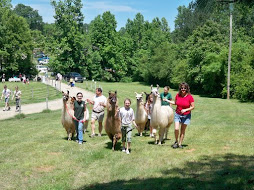What Exhibitors need to know
--------------------------------------------------------------------------------
The criteria and guidelines for each class entered. Know the dress code for that particular show. Know how to use and fit halters and equipment used in classes entered. Understand basic conformation, and general knowledge of showing llamas. Read, review, and understand what is expected in classes that they enter. Get to the gate on time, prior to class, enter ready to show. Understand ring procedure, entering, during and exiting. Trained and well-mannered llamas are a must while showing. Exhibitors are expected to treat their llamas in a humane manner. Attend the judge and exhibitors meeting prior to showing. Learn what to expect from the judge. Attend as many show clinics prior to show time. Enter the show ring with a positive attitude. Build a trust between the llama and the handler, before entering the ring. Enjoy what you are doing and have fun.
--------------------------------------------------------------------------------
Llama Showmanship ClassWhat may the judge be looking for in a Showmanship class Evaluating the handler. Being able to see the llama at all times Check to see if handler is following directions of the judge. HANDLERS AND LLAMAS SHOULD WALK WITH A BRISK,NATURAL STRIDE WHEN-IN THE ARENA. Show the llama to it’s best advantage. Never be between the judge and the llama while showing. Keep an eye on the judge, be alert to all instructions from the judge. Be on time to the entry gate of each class. Have a working knowledge of the showmanship section of the ALSA . Handbook. Training for show takes time and energy. Know your llama. Grooming for most llamas was started many weeks before show time. Make sure llama is clean, free of debris and well groomed. Correct fit of halters on the llamas. Know llama parts, function and nutrition, judge may ask. Train llama to walk smoothly at your shoulder with short loose lead. Allow 5-6 feet between llamas, in front and beside you. Other than grooming and proper tack, the llama is not judged in showmanship. In showmanship classes the handler is judged on how effectively the llama is presented to the judge.
--------------------------------------------------------------------------------
Llama Halter ClassWhat may the judge be looking for in the Halter Class CONFORMATION Soundness and overall balance of the llama. Disposition, eye appeal are also taken into consideration. Llamas are evaluated individually..then compared to one another to determine finale placements.Judges most valuable assessment tool is ‘Observing llamas while they are in motion’Are the rear feet following the front feet. Is the llama standing square, level back, high tail set Judge is also evaluating leg conformations (sickle hocks, weak pasterns) HANDLERS AND LLAMAS SHOULD WALK WITH A BRISK, NATURAL STRIDE WHEN IN THE ARENA.Handlers should maintain adequate spacing between animals at about 5-6 feet. Lead ropes should appear loose rather than pulling the llama. Lead rope and halter should be black. Training doesn’t start in the show ring. Much time is spent prior to show time in training and grooming the llama. The llama should be clean, free of debris and well groomed. Follow directions of the judge. Before showing, visit the designated poop pile so the llama can be more relaxed in the ring and not stall or stop the rest of the class. Walk the llama straight to and away from the judge, this helps the judge evaluate movement, correctness of legs, and tracking of the feet. Handlers should never be between the judge and the llama. Dress for Halter & Showmanship: dark slacks, dark shoes, long sleeve shirts. Be on time for each class
Link to Post - Back to Top Logged
Thursday, June 4, 2009
Subscribe to:
Post Comments (Atom)















































No comments:
Post a Comment